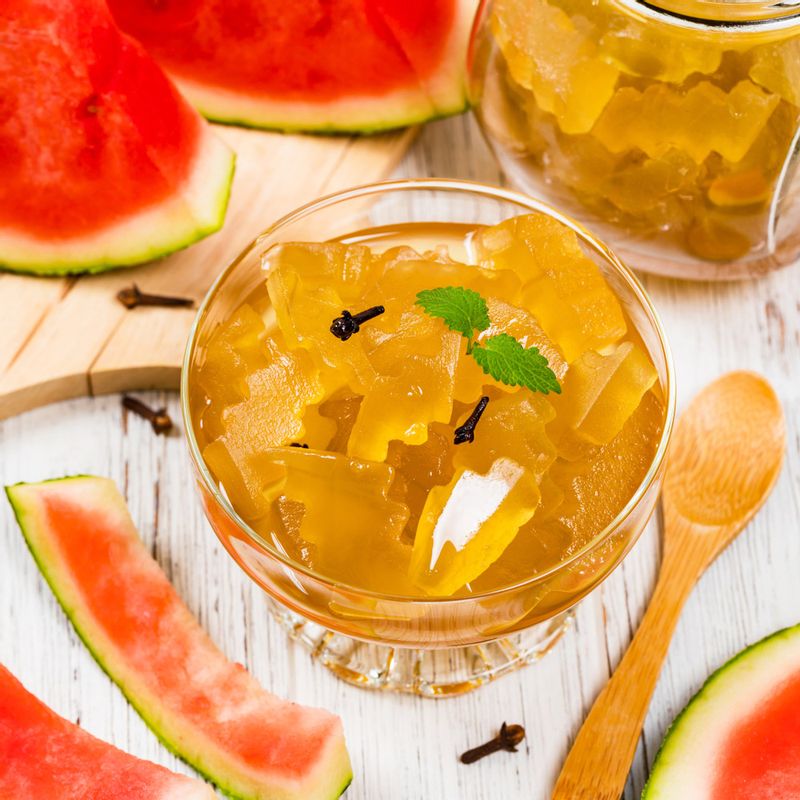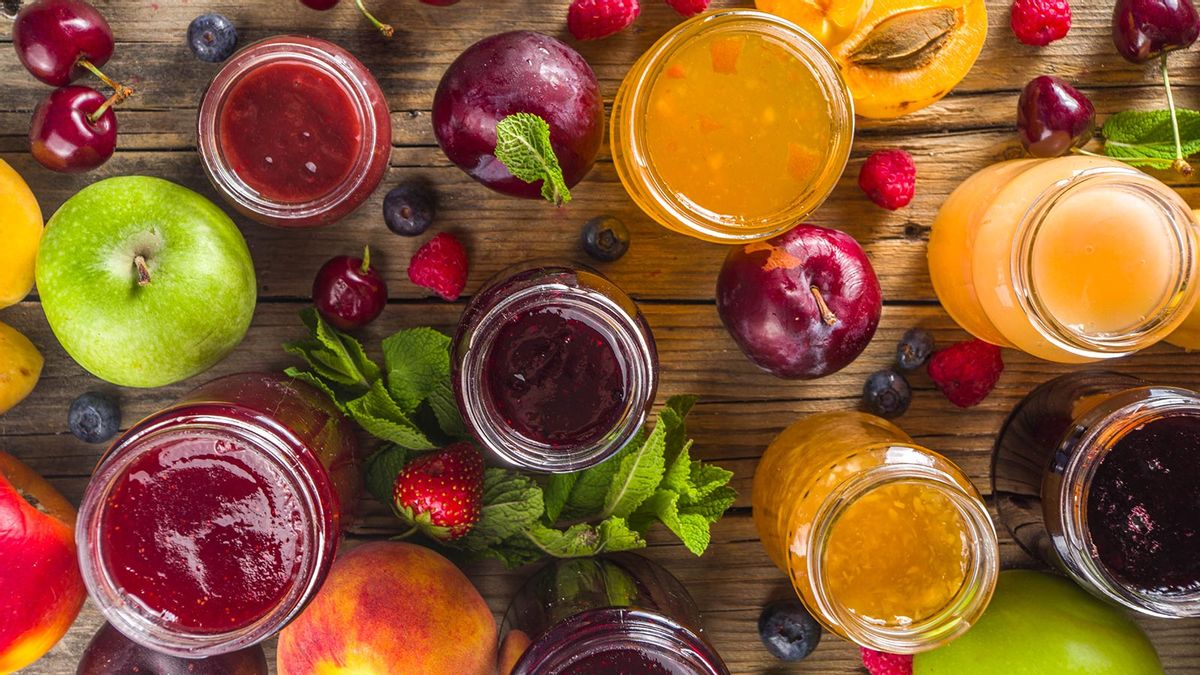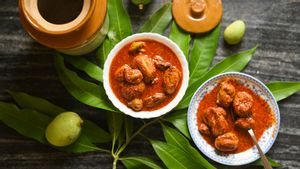Back at grandma’s, when crates of mangoes would appear like clockwork every summer, a few would get devoured by our grubby little hands or turned into milkshakes, but the lion’s share would always end up in the place that allowed us to savour them the longest: the jam jar. I still have vivid memories of my nana peeling and dicing the fruit, the rich aroma of mangoes simmering in a pot, the sound of jostling jars and the sudden unexpected pop of sealed lids – they were all part of the home canning or preserving experience.
The most cherished memory is that of eating grandma’s homemade mango jam slathered on toasted pavs and hot parathas. There’s something about a bottle of homemade jam, the labour of love, time, patience and sticky fingers, to finally be left with jars or barnis (jars) of jam for months to come.
The Power of Jam Making
A fairly simple process that involves the mixing of fruit, sugar and pectin, jam-making necessitates a slow-down. It requires a focus on nothing else: you must stir continuously or disaster may ensue. Starters fail; too much or too little pectin and you’re doomed; left to cook too long, and sugar crystals fleck the surface of the jam. The reason why Navi Mumbai-based Chandrima Sarkar has been making jams for almost seven years now. “I love the whole process of slow-cooked fruits, how they change colours, the aroma, it’s like meditation for me,” she tells us of her jam making experience.

Having ditched store-bought jams for their high sugar content and preservatives, Sarkar has so far experimented with berries, dark cherries, plums, watermelon rind, pears, apples and roselle flowers. Besides, jam is a traditional way of preserving fruits and veggies—a timely idea that could come a long way in your quarantine pantry. “Fruits have a short season in India, like strawberries and fresh figs, it’s nice to preserve them as jams," writes food blogger Nandita Iyer, who has spent most of her summers making batches of mango jam, strawberry and balsamic jam, cherry jam and fig, vanilla and black pepper jam.
Experiments in Jam Making
Once you have down the fundamentals of making jam, it is time to experiment. Ask Anita Tikoo who is daring to try—and succeeding with her quince marmalade with a hint of ginger and a spoonful of chilli flakes or a ‘seriously bitter’ marmalade with four kinds of citrus fruits. She’s busy preserving her surplus garden produce.
The idea of making your own jam might scare you off. But all you need is a few key ingredients and some patience. Here are a few ideas to get you started:
Fruits and veggies
When it comes to making jams you don’t have to strictly play by the rules. A mix of fruits and sugar is as easy as it gets. Vegetables on the other hand may seem daunting but take a cue from Deeba Rajpal, whose love for garlic nudged her to come up with a caramelised onion and garlic jam recipe, which she says pairs wonderfully with pizzas, bagels, toasts and even as salad dressings and sauces. Like her, you too could combine ingredients to produce some innovative offerings.

Spices and infusions
Do not be afraid to add contrast to your fruit’s inherent sweetness with savoury hints of spices like cinnamon, smoked paprika or nutmeg, says Sarkar. That said, always use them sparingly, adding a little in the beginning, then adding more to taste. The idea is to enhance the flavour of the fruit or veggie and not overpower it. You can also add types of vinegar, vanilla extract, peppers and herbs such as rosemary and thyme in your jam.
Sometimes, like everything, jams too taste better with a little booze. Think whiskey, rum, tequila, bourbon, brandy and gin. Blogger and food writer Monika Manchanda leads the way with her grape, ginger and wine jam recipe.
Easy jam recipes to try at home
If you’re too intimidated by the boiling, stirring and sterilising, here are two mini-batch jam recipes you could start with. And forgive yourself if your first jam doesn’t come out right.
Chandrima Sarkar’s Watermelon Rind Jam Recipe

Ingredients
- 2 cups watermelon rind
- 1 cup granulated sugar
- 2 tbsp honey
- 1 tsp fresh ginger, grated
- 2 green cardamom, discard the peels and grind the seeds to a fine powder
- 1 tsp white vinegar
Method
- Scrape off the green part from the watermelon rind. Now cut the rind into half-inch width-wise and 2-inch length-wise pieces.
- In a deep bottomed pan, add the watermelon rind pieces along with water. The water level should be three inches up from the watermelon rind pieces.
- Give this a quick boil over high heat. Once it boils, reduce the heat and simmer over low-medium heat for 30-40 minutes or until the rind pieces look translucent and tender (check by poking with a fork). You might need to add more water during this step.
- There should be enough liquid along with the cooked rind pieces in the pan. The level of the liquid should be one inch above the cooked rind pieces while you’re removing the pan from the heat.
- Drain the rind pieces on a strainer, and reserve the liquid.
- Now in a pan add the reserved liquid and sugar. Keep stirring over medium heat until the sugar granules melt completely.
- To this, add honey, grated ginger, and vinegar, and cardamom powder, mix well over low heat.
- Add in the cooked rind pieces. Now, with a masher start mashing the rinds. We’re looking for a coarse, chunky preserve here.
- Stir and keep cooking over low heat (15 minutes approximately) until the jam thickens. You don’t want to make the jam too thick, otherwise, it wouldn’t be in a spreadable consistency.
- Do the jam test at this stage: put a few drops of jam on a dry plate, wait for a few seconds, drag a finger through it, if the jam is ready, the parting made by the finger will remain open, if it runs together, cook for some more time.
- Remove from the heat, let the jam sit in the same pan to get completely cold at room temperature before transferring into a jar.
Keep refrigerated at all times. Make sure to use a dry spoon every time.
Anita Tikoo’s Lemon/Lime Marmalade

Ingredients
- 2 cups lemons/limes, thinly sliced (if your lemons/limes are large, cut slices into half-rounds)
- 1/2 tsp soda-bi-carb (optional)
- 4 cups sugar
- 3+1 cup water
- 1/2 cup pips (any citrus fruit)
- 2 hot dry red chilli peppers, dry roasted and crushed (optional)
Method
- Wash and thinly slice the lemons (or limes). Bring 3 cups of water to boil and add the soda. Drop in the sliced lemons and simmer till the peels have cooked.
- While the lemons are cooking, boil the pips in 1 cup of water for about half-an-hour. Strain this pectin-rich syrup and reserve.
- To the cooked lemons add the sugar, a little at a time, so that the liquid is always boiling. Once all the sugar has been added bring to a rolling boil. Next, add the pip-syrup, and boil for 10 minutes.
- Reduce the heat and boil till setting stage. You can test by spooning some preserve on to a cool plate and keeping in the freezer for a minute or so. If setting point has been reached, a skin will form over the surface which should wrinkle when pushed.
- Dry roast and crush the chilli peppers, if using, and mix in before pouring the hot marmalade into sterilized jars. Screw on the lids and store.



